Local Airdrop Training – Ready When the Mission “Drops”
Szöveg: Captain (OF-2) Henrik Gebhardt/Swedish Air Force | 2017. április 1. 7:0127 MAR 2017 – PÁPA – – Every month the Heavy Airlift Wing conducts local airdrop training in one of the drop zones near Pápa Air Base. Key players in this training event are the Heavy Airlift Squadron and Aerial Port section of the Logistics Support Squadron.
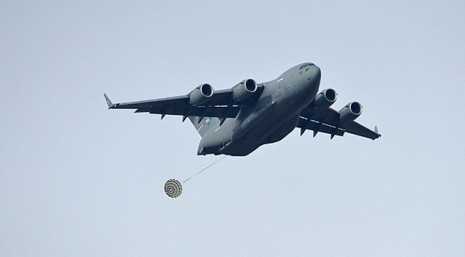
The drogue chute is out. It will soon be followed by the extraction chute and main chute. Photo: HAW / Henrik Gebhardt
Right on time, one of the SAC C-17s appears at the skyline a couple of minutes west of the drop zone. Intense radio traffic begins between the Hungarian Defence Forces Joint Terminal Attack Controllers (JTACs), and the pilot in command on board the aircraft. The JTACs give the pilots updated information on the weather and wind conditions in the drop zone, and also give them the all-clear to make the drop.
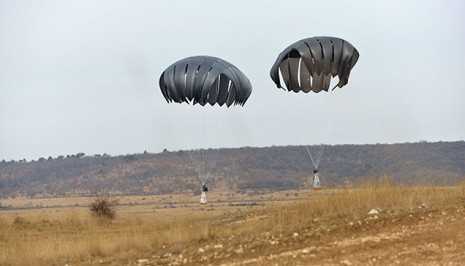
CDS bundles equipped with single use LCADS parachutes. Photo: HAW / Henrik Gebhardt
Captain LeRoi Edwards, the Heavy Airlift Wing Aerial Port’s Air Movements Officer, explains that the whole event is a display of interaction with the host nation, Hungary. A Drop Zone Control Officer and two JTACs from the Hungarian Defence Forces augment the recovery team to communicate with the aircraft overhead to ensure max safety and training accomplishment. In addition, logistics support personnel from Györ, Pápa, and Veszprém are also engaged to make the morning’s air delivery operations a success.
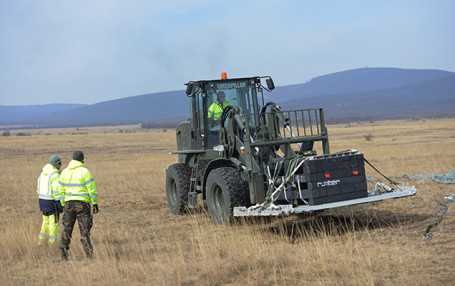
The team from Aerial Port recovers a platform for heavy equipment. Photo: HAW / Henrik Gebhardt
First out of the plane are two platforms for heavy equipment, followed by the smaller Container Delivery System (CDS) bundles on the next pass. Staff Sergeant John Cushman, Lead Rigger from the Heavy Airlift Wing Aerial Port section, explains that the bundles are equipped with different kinds of parachutes. Some of them are equipped with normal reusable parachutes, while others are equipped with a special type of single use parachute, developed for a system called LCADS, or Low Cost Aerial Delivery System. The LCADS parachute is made from strips of polypropylene instead of nylon, the traditional material used in making parachutes. Coming prepacked, they save time, money, and are valuable for airdrops where parachute recovery is not likely.
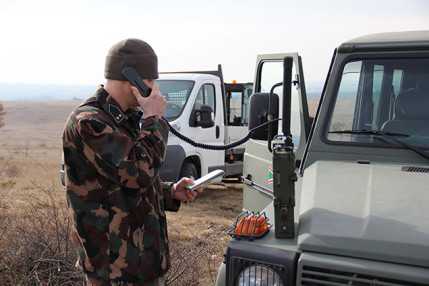
An HDF JTAC communicates with the SAC C-17 overhead. Photo: HAW / Brandon T. Nicely
To only drop a couple of CDS bundles might seem a bit on the low side, but in this particular training mission, the total number of items dropped have no impact on meeting the currency training objectives. To meet the training objectives the aircrews need to use the proper techniques and procedures to conduct the drop, how many bundles that go off the ramp is of secondary significance.

A platform for heavy equipment on its way to the ground. Photo: HAW / Brandon T. Nicely
After five passes, the local airdrop training concludes for the aircrew. Now the recovery work begins for the Aerial Port. Designated teams storm the drop zone and begin collecting the variety of specialized equipment, which is then repacked and loaded onto vehicles heading back to Pápa Air Base. Back at Pápa Air Base, Aerial Port will begin the multi-day technical process of inspecting, preparing, and repacking equipment to be ready when the next mission “drops."
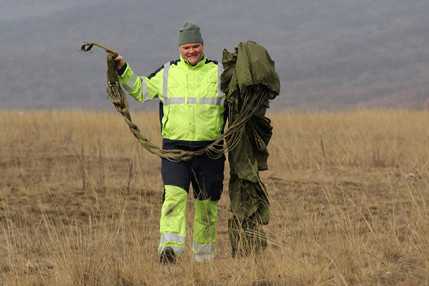
An Aerial Port technician recovers a parachute. Photo: HAW / Brandon T. Nicely